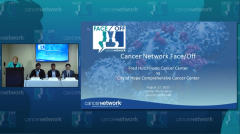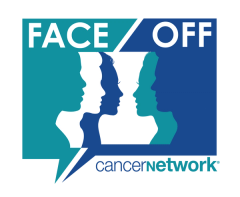
Asciminib in CML Treatment: Efficacy and Responses Shown in the ASCEMBL Study
A review of promising results from the ASCEMBL study, highlighting asciminib's superior efficacy, well-tolerated profile, and potential impact on chronic myeloid leukemia treatment options.
Episodes in this series

Transcript:
Judy Schreiber, PhD, RN: Fantastic. This really has been a great discussion. Now it’s Dr Oehler’s turn to present. And she’ll be presenting [2] different [abstracts], so we will do the question-and-answer after each abstract. So the first one would be on the olverembatinib. I practiced that from the last time I tried to say it. And then the second one, we’ll introduce that at the appropriate time. Thank you.
Vivian G. Oehler, MD: There is a theme here, I think, for Dr Koller’s and my presentation. We talked about ponatinib in detail. [We’re talking] about olverembatinib. We’re talking about asciminib. So these are therapeutics that are generally used in the third line….
I wanted to just set the stage a little bit. Many of you know that CML [chronic myeloid leukemia] now is generally a disease where most patients with chronic phase CML [CPCML] have normal life expectancy. But there is a small group of patients, especially as we go from line to line to line, who don’t share that really excellent outcome.
And what I show here are data from MD Anderson. Between…2005 to 2015, you can see with each subsequent line of therapy, overall survival and transformation-free survival increases. So what are our choices in this space? When you head toward the third line, you can use another second-generation TKI [tyrosine kinase inhibitor], and we’ll talk about the pros and cons of that. Then in the third line, we have ponatinib, which was approved in later lines. To be honest, it can also be used in the second line in some risky patients. [It] was also specifically approved for the T315I mutation. Then asciminib, which was FDA-approved for CPCML in November 2021, is approved in the third line and beyond, and also for T315I-mutated CML.
Undergoing clinical trials are new third-generation drugs, including olverembatinib, which I’ll discuss, vodobatinib, and there are new allosteric inhibitors in the pipeline…. Asciminib has a very different mechanism of action. Well, not very different, but a different mechanism of action than the TKIs. And so, as I show here in the cartoon [to the] left, you can see that asciminib is binding to the myristoyl pocket here rather than the ATP binding site. And because of this difference in how it works, it has a very high selectivity and a very narrow target profile with [fewer] off-target effects. So it’s active against many mutations that confer resistance to the TKIs, and this includes the T315I mutation, which is only treated by ponatinib.
In 2019, in the New England Journal of Medicine, the phase 1 data were presented by Dr Hughes and colleagues demonstrating safety, efficacy, and tolerability. The ASCEMBL study was a randomized phase 3 study, and we enrolled patients…previously treated with 2 or more TKIs. If you came on the study for intolerance, you had to have a BCR-ABL greater than 0.1% at screening. We excluded patients with T315I and B299L because those drugs do not work for patients with bosutinib. And so, patients were [randomly assigned 2:1] to asciminib at 40 mg twice daily versus bosutinib at 500 mg daily. Now…if you had no efficacy response on bosutinib, you were allowed to cross over, but neither of the 2 publications that we have so far include those patients.
With regard to the demographics and the baseline characteristics, I will say they were mostly well-matched. There were some differences, and I put little boxes around them to help see these. Slightly more women in the bosutinib treatment arm. Additionally, in terms of the reason for discontinuation of your last TKI, there were more patients in the bosutinib arm that had discontinued their last TKI for efficacy, whereas in the asciminib arm, this was for tolerability. And in the bosutinib arm, there were also slightly more patients who were on later lines of therapy. The primary end point was the MMR at 24 weeks. That’s the major molecular response rate. That’s a BCR-ABL of less than or equal to 0.1%. And as you can see here, it was superior…[in] asciminib-treated patients, 25.5%, versus 13.2% in bosutinib-treated patients.
And because of the differences in the study arm, these data were actually adjusted for the major cytogenetic response rate at baseline when you came on the study. So…the first paper was by Dr Réa published in 2021. And Dr Hochhaus has just published with his colleagues the data in Leukemia in 2023. And so, you can see over time, actually, the difference between the 2 arms has increased and MMR [major molecular response] at 96 weeks. A key secondary end point was 37.6% versus 15.8%. I’ve also included this slide here, which is complete cytogenetic response. This was [a] secondary end point, but I think it’s important because there’s a long-term survival benefit from achieving this response, which is less than or equal to 1%. So, for asciminib-treated patients at 24 weeks, 40.8%, versus 24.2% in bosutinib-treated patients.
Importantly, in the asciminib treatment arm, you could continue to achieve that response over time. And this is from the new paper by Dr Hochhaus, which was the 41.2%, with less of a change observed in the bosutinib treatment arm. But I will say that there are a lot [fewer] patients in this treatment arm. So, if you did achieve MMR or BCR-ABL of less than or equal to 1%, your probability of maintaining that response for more than 72 weeks was excellent. It was 96.7% in the asciminib treatment arm and 92.9% in the bosutinib treatment arm. And we also know that the safety profile of asciminib looks quite excellent, so many of us who use bosutinib in our practice know that 400 mg and 500 mg of bosutinib is associated with very high rates of GI [gastrointestinal] toxicities. Those are the big blue bars you’re seeing. You can see there’s very little GI toxicity, rash, or transaminitis with asciminib, but not surprisingly, in a heavily pretreated group, we did see hematologic AEs, and they were no different between the 2 treatment arms.
In terms of discontinuation…what happened to patients who stopped asciminib? Well, only 24.2% stopped for efficacy versus 35.5% for bosutinib, but in the blue box, you can see that 3 times as many patients discontinued for adverse events in the bosutinib treatment arm. And so I wanted to finish with a little bit about efficacy in patients with a high burden of disease. That’s really hard to parse out from the asciminib treatment study, so I have an abstract really briefly here that was presented at ASH [the American Society of Hematology Annual Meeting] last year from 14 UK centers. The take-home point from this is patients who have high burden of disease, BCR-ABL greater than 1%, CCyR [complete cytogenic response], or MMR greater than 10% are much less likely to respond to asciminib. Specifically for people with high burden of disease with high BCR-ABL, only 17% achieved MMR on asciminib versus 84%.
In conclusion, I think we have shown, at least against bosutinib, that there’s a superior efficacy for asciminib. It’s well-tolerated. Responses are durable, and I’ll say the rate of AOEs [arterial occlusive events] so far are reasonably low. So there were in the asciminib treatment arm at the first presentation. Three more have been reported subsequently, but it will be impossible to compare the 2 arms due to the discontinuation rate in the study. I will say, in keeping with the real-world data, high burden of disease we know may respond less well, so be cautious. And there are mutations that may not respond as well. And one of these is the one involving amino acid 337, which is already in the NCCN [National Comprehensive Cancer Network] guidelines just published. So, caveats—well, you have to ask the question, is another second-generation TKI in someone who’s failed a second-generation TKI reasonable? Ponatinib would’ve been better, and will asciminib have an AOE signal with longer term follow-up?
Transcript is AI-generated and edited for clarity and readability.
Newsletter
Stay up to date on recent advances in the multidisciplinary approach to cancer.



















































































